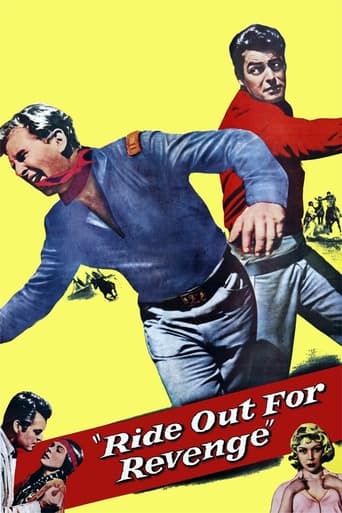MartinHafer
Some westerns portrayed the American Indians as unthinking, one- dimensional idiots--riding around in circles waiting to be picked off by folks in the wagon train or by the cavalry. Others, like this one, are more sympathetic and show these same people as multidimensional and decent.When the film begins, the local chief is murdered. This is a serious problem, as the chief was a man of peace--and the new, younger chief is more headstrong and ready for revenge. Fortunately, there is a local guy (Rory Calhoun) who understands these Indians and treats them decently--and he can diffuse the situation. But the town is a hellish place that wants no part of peace and the local cavalry commander (Lloyd Bridges) is a cowardly jerk-face. With the Indians on the warpath and Calhoun's character the only person with any common sense, things look pretty awful for this stupid town.The Indians are generally portrayed well. However, a complaint I often have is that the main Indians are played by white folks--such as Vince Edwards! So, it's like two steps forward and one step back. Overall, however, the film is interesting and presents a more balanced view of the west. The only problem is that, at times, the characters are a bit more like caricatures--a bit too one- dimensional to be believable.
bkoganbing
Ride Out For Revenge is a sincere portrayal of the anguish of the American Indians, the Cheyennes specifically, in the aftermath of losing the Indian Wars. It also shows the bitter prejudice of the white settlers who have also suffered losses as a result of the wars.The problem I find with this film is the rather unbelievably noble portrayal of Rory Calhoun in the lead. Not his fault, there's not much he can do with a character that's just too good. As is explained he's sustained personal losses himself, a sister and husband killed and he's raising his nephew Michael Winkelman and boarding with widow Gloria Grahame. As fetching as she ever was in movies, Grahame's got a real thing for Calhoun and he may have given her a tumble once or twice, but right now Rory has got eyes for Indian maid Joanne Gilbert.I'm also not sure why a troop of cavalry is stationed in the town where Calhoun is marshal. But they're there and headed by Lloyd Bridges a captain who never would have found his way into any John Ford cavalry film. He's as slimy as they come. When chief Frank DeKova comes into town to plead for supplies for his people, he gets shot down in the street like a dog and son Vincent Edwards vows vengeance. That sets in motion all the events of the film that follows.With characters I just could not buy, Ride Out For Revenge falls short of its goal for sympathy for the Cheyenne. One of the main characters dies and one is thought to have died in the end. The actual death of the first should have set off a big inquiry.Kirk Douglas's Bryna Productions produced this one and Kirk was wise not to take the lead himself here.
Scott LeBrun
More sensitive to the feelings of the Indian people than other films of the time, the watchable B Western "Ride Out for Revenge" has some good performances and a decent story to recommend it, even if it's heavy handed in pushing its message home and ultimately forgettable. It does take the viewer out of the movie to see obviously white people playing Indian characters, but then Hollywood still wasn't ready in 1957 to be truly politically correct.The stolid Rory Calhoun plays Tate, a marshal from the small town of Sand Creek who's sympathetic towards the local Cheyenne tribe. Of course, helping him to form that opinion is his love for Pretty Willow (Joanne Gilbert), the daughter of the tribes' chief Yellow Wolf (Frank DeKova). When the chief is cold bloodedly murdered by a gunman, it angers the chiefs' son Little Wolf (Vince Edwards) who leads his people in a raid. Even after suffering a personal loss during the raid, Tate finds that taking care of business is still a tough proposition.Calhoun is fine, Edwards amusing even in light of his miscasting, and Gloria Grahame makes the most of her not terribly important role. But the movie really belongs to a wonderful Lloyd Bridges, who's perfectly slimy as a racist, greedy, cowardly Cavalry officer. It's Bridges who keeps things interesting for the duration; surely a member of the Cavalry had never been portrayed in this negative a light before. Otherwise, nothing about this is anything special - not the direction (by Bernard Girard) nor the script (by producer Norman Retchin, based on a novel by Burt Arthur), although the music (by Leith Stevens) and cinematography (by Floyd Crosby) are nice.Overall, not a bad way to spend 78 minutes.Six out of 10.
doug-balch
You might be tempted to watch this movie when you see that Gloria Graham is the female lead and that Lloyd Bridges costars. Don't make that mistake.This thing looks like a high school play. It's a "civil rights" Western, where the Indians are a metaphor for blacks in the South.OK message, but there is no art to this movie. Graham's part is nothing. Bridges has just a little more to work with, playing a sleazy, cowardly cavalry captain.This is a good opportunity though to categorize three types of Westerns:The "Cold War" Western, where the cowboys represent freedom and individuality, while the Indians are a foreign menace trying to take their freedom away. All that stands between freedom and destruction is the bravery of the U.S. cavalry.The "Civil Rights" Western, where the whites are the bad guys oppressing a racial minority.The "Vietnam" western, where the oppression of the Indians becomes a much wider metaphor for global Western imperialism and colonization.


